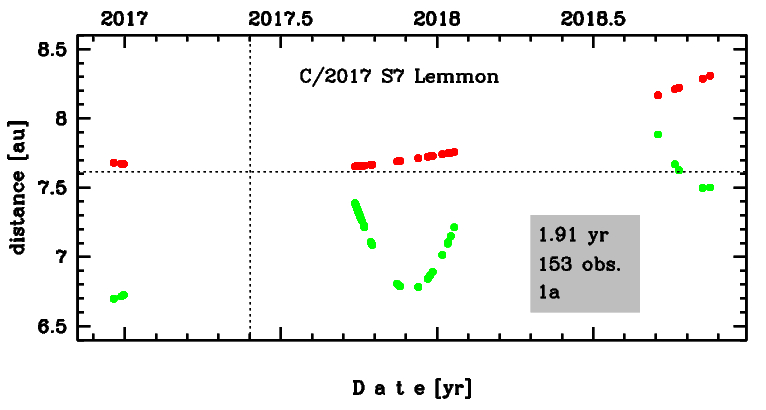C/2017 S7 Lemmon
more info
Comet C/2017 S7 was discovered on 26 September 2017 with Mount Lemmon survey, that is about 4 months after its perihelion passage. Several prediscovery images of this comet were found: taken by the same survey from 18, 27 and 30 of December 2016. This comet was observed until 4 December 2018.
Comet had its closest approach to the Earth on 18 December 2016 (6.698 au), exactly the same day as the first pre-discovery image were taken; almost 5.5 months before its perihelion passage.
The preferred solution given here is based on data spanning over 2.89 yr in a range of heliocentric distances: 8.22 au – 7.61 au (perihelion) – 8.22 au.
This near-parabolic comet suffers insignificant planetary perturbations during its passage through the planetary system (original and future semimajor axes between 9,000 and 10,000 au).
Comet had its closest approach to the Earth on 18 December 2016 (6.698 au), exactly the same day as the first pre-discovery image were taken; almost 5.5 months before its perihelion passage.
The preferred solution given here is based on data spanning over 2.89 yr in a range of heliocentric distances: 8.22 au – 7.61 au (perihelion) – 8.22 au.
This near-parabolic comet suffers insignificant planetary perturbations during its passage through the planetary system (original and future semimajor axes between 9,000 and 10,000 au).
| solution description | ||
|---|---|---|
| number of observations | 153 | |
| data interval | 2016 12 18 – 2018 11 15 | |
| data type | perihelion within the observation arc (FULL) | |
| data arc selection | entire data set (STD) | |
| range of heliocentric distances | 7.68 au – 7.62 au (perihelion) – 8.31 au | |
| detectability of NG effects in the comet's motion | NG effects not determinable | |
| type of model of motion | GR - gravitational orbit | |
| data weighting | YES | |
| number of residuals | 298 | |
| RMS [arcseconds] | 0.37 | |
| orbit quality class | 1a | |
| orbital elements (heliocentric ecliptic J2000) | ||
|---|---|---|
| Epoch | 2017 06 16 | |
| perihelion date | 2017 05 27.97757714 | ± 0.00456201 |
| perihelion distance [au] | 7.61440553 | ± 0.00001021 |
| eccentricity | 1.00230740 | ± 0.00000941 |
| argument of perihelion [°] | 187.752935 | ± 0.000314 |
| ascending node [°] | 262.786942 | ± 0.000022 |
| inclination [°] | 124.219818 | ± 0.000045 |
| reciprocal semi-major axis [10-6 au-1] | -303.03 | ± 1.23 |
